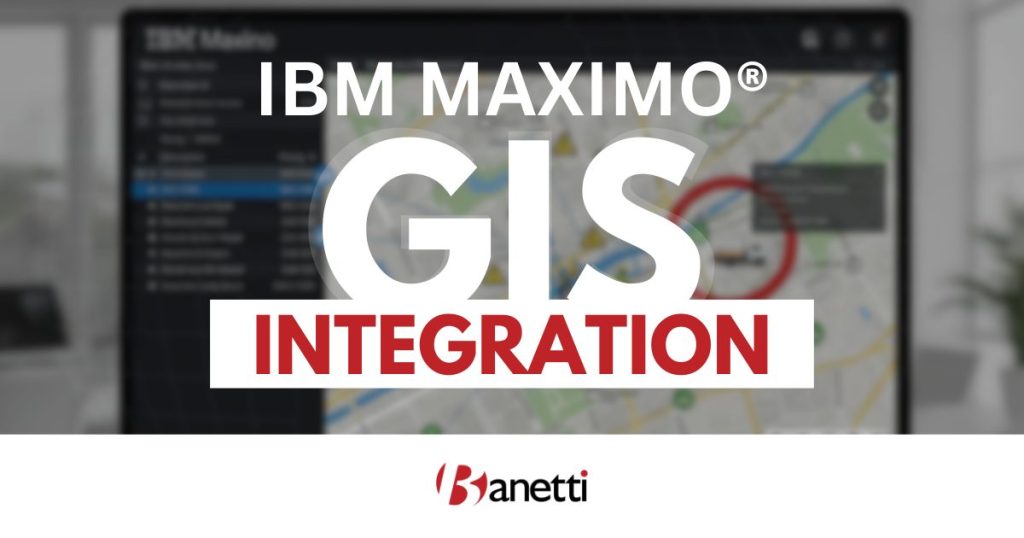5 Min Read
Table of contents

In asset-intensive industries, the need to combine location awareness with operational intelligence has never been more urgent. IBM Maximo® GIS integration offers organizations a way to synchronize data between enterprise asset management (EAM) systems and geospatial platforms like Esri’s ArcGIS.
By enabling a unified view of assets, service requests, and workflows on an interactive map, businesses can reduce complexity, minimize discrepancies, and drive better decisions. This seamless integration of IBM Maximo® and GIS records enriches enterprise operations with context, precision, and real-time visibility.
What Is IBM Maximo®️ GIS Integration?

To understand the value of integrating GIS with IBM Maximo®, it’s important to first look at what IBM Maximo® Spatial is, how it works, and the role it plays in managing data across both systems.
Spatial extends IBM Maximo® by embedding ArcGIS capabilities directly into the system. Through its map tab and map windows, users can view assets, locations, and service requests in a geospatial context. This provides a consistent way to analyze GIS objects, link IBM Maximo® business objects, and ensure address data is standardized across the organization.
Overview of IBM Maximo®️ Spatial Module
The IBM Maximo® Spatial module allows teams to create GIS objects that represent assets, facilities, or infrastructure elements. These objects can be connected to IBM Maximo® classifications, attributes, and work orders. By making GIS records directly accessible, Spatial ensures that geospatial functionality is not an isolated tool but an integral part of asset management.
How the Integration Works
At its core, IBM Maximo® GIS integration relies on web services, ArcGIS Server endpoints, and synchronization rules. ArcGIS FeatureServer and MapServer provide map services that IBM Maximo® can consume through configuration in the Map Manager. Data is synchronized via scheduled cron tasks or real-time connectors such as Geonexus Technologies’ platform, ensuring that GIS and IBM Maximo® records remain aligned.
Advanced integration options include tools like Naviam GIS PowerSync, which provide error-free synchronization, validation, and automation of data exchange. These integrations eliminate manual effort while maintaining accuracy and security across systems.
Key Features of IBM Maximo®️ GIS Integration

IBM Maximo® Spatial offers a range of features that bring geospatial intelligence directly into enterprise asset management, from interactive mapping to data synchronization.
Interactive Spatial Visualization
The integration enables a map tab within IBM Maximo® where users can visualize assets, GIS objects, and related records. For utilities, transportation networks, or campuses, this unified view shows spatial relationships and helps identify clusters of work orders or service requests. The ability to highlight features and attributes on maps enriches decision-making by providing instant geospatial context.
Geospatial Work Order Management
With GIS enabled, users can create or update work orders directly from the map interface. Crews can locate assets, analyze surrounding conditions, and plan routes more effectively. For organizations managing a large range of locations, this capability reduces travel time and boosts field productivity.
Indoor GIS & Mobile Enablement
Integration with ArcGIS Indoors and mobile applications enables teams to access maps on the go. Field technicians can pull up attributes, parameters, and GIS records directly on their devices. This mobile-enabled functionality improves workflows by giving teams the ability to access and update asset values from anywhere.
Bi-Directional Data Synchronization
IBM Maximo® integration supports both scheduled and real-time synchronization. Assets created in GIS can trigger the creation of records in IBM Maximo®, while updates in Maximo are synced back to GIS. This ensures that both systems reflect the latest status of assets, service requests, and classifications without duplication.
Benefits of Integrating GIS with IBM Maximo®

The integration delivers tangible business benefits by improving efficiency, enabling smarter workflows, and ensuring greater accuracy across teams and systems.
Improved Operational Efficiency
By connecting GIS and IBM Maximo® systems, organizations eliminate redundant data entry and minimize discrepancies. Synchronizing data ensures that updates populate across both systems automatically, freeing teams from manual work.
Faster and More Accurate Field Workflows
Field workers benefit from the ability to view work orders, service requests, and assets on a unified map. This reduces time spent locating infrastructure, ensures classifications are accurate, and improves the ability to match resources to field requirements.
Real-Time Visibility for Decision-Makers
Managers gain access to accurate, up-to-date records that can be viewed spatially. Whether analyzing pipelines, roads, or utility networks, decision-makers can identify risks and prioritize resources with confidence. Features such as discrepancy reporting and validation, offered by Geonexus Technologies and Naviam, add further value by ensuring data integrity.
Enhanced Indoor Asset Management
IBM Maximo® Spatial offers built-in signature options to control user access to GIS objects and layers. Organizations can configure which users have the ability to create, edit, or link map features, ensuring sensitive data is secure.
Streamlined Compliance and Reporting
With synchronized records and attributes, regulatory reporting becomes more accurate and less time-consuming. Automated integration reduces the complexity of compliance tasks while offering auditable, validated data flows.
Integration Methods

Organizations have multiple ways to integrate IBM Maximo® with GIS, depending on their requirements, IT landscape, and long-term data strategy.
Native IBM Maximo® Spatial Configuration
Organizations can configure ArcGIS Server services directly in IBM Maximo® using the Map Manager. GIS objects are created by associating feature services with IBM Maximo® business objects such as assets, locations, or work orders. This out-of-the-box functionality is particularly useful for organizations already invested in Esri GIS.
Scheduled Synchronization (Cron Tasks)
Using cron tasks like AssetSync, LocationSync, or ArcGISDataSync, IBM Maximo® can automatically synchronize records on a scheduled basis. These processes ensure assets and service requests remain consistent between systems without requiring manual intervention.
Third-Party Integration Platforms (e.g., Geonexus)
Solutions such as Geonexus’ GeoWorx Sync or Naviam GIS PowerSync provide no-code, real-time synchronization. These tools offer full support for IBM Maximo® business objects, classifications, and attributes, while simplifying integration complexity.
Custom Integration Approaches
For legacy systems or unique requirements, organizations may develop custom REST APIs or scripts. These allow for tailored synchronization and the ability to handle specialized parameters or workflows.
Use Cases for IBM Maximo®️ GIS Integration

From utilities to transportation to campus environments, IBM Maximo® Spatial integration can be tailored to meet the diverse needs of different industries.
Utilities and Energy
Utility companies rely on linear assets such as pipes, poles, or cables. By synchronizing data between GIS and IBM Maximo®, they gain visibility into asset locations, service histories, and risks. Work orders can be displayed on the map, and crews can optimize deployment routes.
Transportation and Infrastructure
Departments of transportation and transit authorities benefit from visualizing roadwork, bridges, and incidents within Maximo. GIS integration supports faster response times by enabling map-driven creation of service requests and work orders.
Facilities and Campus Environments
Universities, hospitals, and corporate campuses use IBM Maximo® Spatial with ArcGIS Indoors to provide digital twins, indoor navigation, and maintenance coordination. Assets and service requests can be located quickly within complex building environments.
Conclusion
Integrating IBM Maximo® with GIS enables a unified view of enterprise data, assets, and workflows, helping organizations move from reactive operations to proactive, data-driven strategies. With features like real-time synchronization, secure web services, and mobile-enabled functionality, IBM Maximo® Spatial reduces complexity while delivering measurable benefits.
To fully maximize the potential of IBM Maximo® and avoid common integration pitfalls, businesses need the right partner. Banetti, a leading EAM consulting platform, specializes in helping organizations implement IBM Maximo® and unlock its full capabilities. By working with Banetti, companies gain expert guidance, customized workflows, and long-term support that ensures sustainable value from their IBM Maximo® investment.


